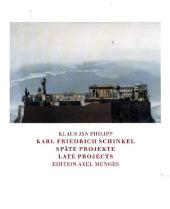 Neuerscheinungen 2014Stand: 2020-02-01 |
Schnellsuche
ISBN/Stichwort/Autor
|
Herderstraße 10
10625 Berlin
Tel.: 030 315 714 16
Fax 030 315 714 14
info@buchspektrum.de |

Klaus J. Philipp
Karl Friedrich Schinkel: Späte Projekte. Late Projects
Sonderausg. 2014. 236 S. m. 45 SW- u. 30 Farbabb. 30 cm
Verlag/Jahr: EDITION AXEL MENGES 2014
ISBN: 3-936681-78-3 (3936681783)
Neue ISBN: 978-3-936681-78-9 (9783936681789)
Preis und Lieferzeit: Bitte klicken
Karl Friedrich Schinkel called his designs for a palace on the Acropolis in Athens and for Orianda Castle in the Crimea a "beautiful dream". They date from 1834 and 1838 and were Schinkels last major projects, in which he presented his ideal of architecture in brilliant drawings and watercolours, as if in a last will and testament. Both the formal language of neo-Classical architecture and the quality of presentation are brought to a level here that can scarcely be surpassed. It is clear how highly Schinkel himself esteemed these two unrealized designs from the fact that he had them printed as coloured lithographs in his publication Werke der höheren Baukunst für die Ausführung erfunden (Potsdam 1840 to 1842). These lithographs are reprinted in a large format, complemented by the no less spectacular lithographs of the two Pliny villas, Tusculum, and Laurentinum. These works, which represent ahighpoint in the long story of the reconstruction of the two villas that have come down to us only in literature, also show Schinkels impressive ability to demonstrate and convey his architectural ideas. He is profoundly concerned, both in the reconstructions of the Pliny villas and in the designs for the royal palace on the Acropolis and Orianda Castle to be archaeologically precise and to fulfil prescribed building programmes, but also to plumb the possibilities of architecture beyond mere utility. For the Acropolis palace project hehad his eye mainly on the way in which the new building would interact with the surviving remains of the Propylaea and the Parthenon. In the Orianda project it is a glazed observation pavilion in the form of a temple that expresses architectures perception of itself more clearly than perhaps ever before. Klaus Jan Philipp studied art history, archaeology, and history in Marburg and Berlin. He gained his doctorate with a thesis on medieval architecture in southwest Germany. From 1988 to 1990 he worked as a free-lance at the Deutsches Architekturmuseum in Frankfurt am Main, where he organized the exhibition "Revolutionsarchitektur. Ein Aspekt der europäischen Architektur um 1800". Philipp is professor of architectural history at Stuttgart University. He presented his research on neo-Classical architecture in 1997 in the post-doctoral thesis Um 1800: Architekturtheorie und Architekturkritik in Deutschland zwischen 1790 und 181
Klaus Jan Philipp studierte Kunstgeschichte, Archäologie und Geschichte in Marburg und Berlin. Er promovierte über mittelalterliche Architektur in Südwestdeutschland. 1988-90 war er freier Mitarbeiter am Deutschen Architekturmuseum in Frankfurt am Main und organisierte dort die Ausstellung Revolutionsarchitektur. Ein Aspekt der europäischen Architektur um 1800. Seit 1989 ist Philipp am Institut für Architekturgeschichte der Universität Stuttgart tätig, zunächst als wissenschaftlicher Assistent und seit 1996 als Dozent. Seine Forschungen zur klassizistischen Architektur legte er 1997 in seiner Habilitationsschrift Um 1800: Architekturtheorie und Architekturkritik in Deutschland zwischen 1790 und 1810 vor.


